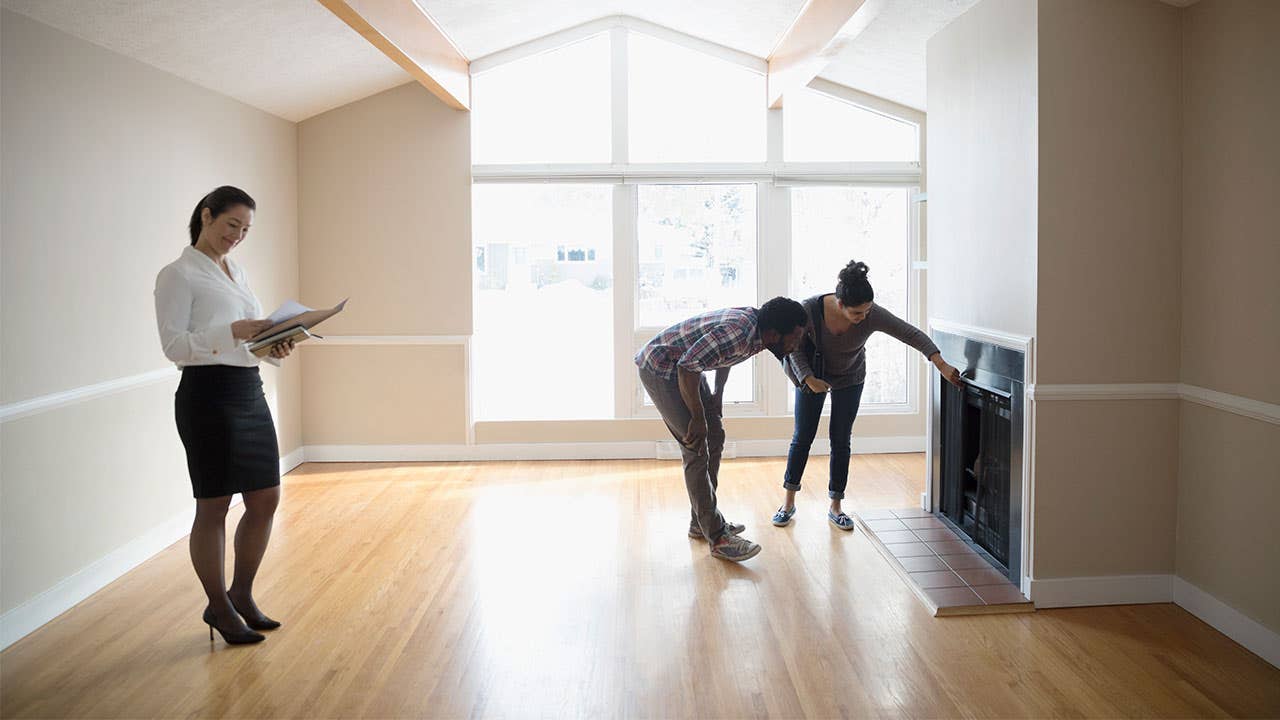The final walk-through: Top tips for homebuyers

The Bankrate promise
At Bankrate we strive to help you make smarter financial decisions. While we adhere to strict , this post may contain references to products from our partners. Here's an explanation for .
Key takeaways
- The final walk-through lets homebuyers verify that the property is in the same condition as when the offer was made, and all agreed upon repairs have been completed.
- It is typically scheduled for the day before or day of the closing.
- If any issues are found, it's important to communicate them to the seller right away to find a resolution before closing.
Buying a home in today’s market can come with an overwhelming sense of pressure. That’s particularly true in expensive areas where low housing inventory has led some buyers to desperate measures, like waiving the home inspection. But there is one essential step everyone should complete before closing: the final walk-through. No matter where you’re buying a home, you should never skip this critical piece of the puzzle.
“You want to make sure the home is in the same condition as when the offer was made,” says Andy Peters, a real estate broker and co-founder of the Peters Company, a Keller Williams Realty team in the Atlanta area. “If a seller is doing negotiated repairs or improvements, you want to verify that they were, in fact, done — and done correctly.”
When it’s time for the final walk-through, you’re almost at the finish line, when the keys will officially be yours. Before the seller hands them over, follow these tips to unlock the door to a bright future in your new home.
Who attends a final walk-through?
Typically, the final walk-through is attended by the buyer and the buyer’s real estate agent, without the seller or seller’s agent present. This gives the buyer the freedom to inspect the property at their leisure, without feeling pressure from the seller.
If the property is a new home, a builder or contractor may attend. “New-build walk-throughs are looking for defects as well as cosmetic issues. A new home is delivered in a more ‘fresh out of the box’ way, so expectations are generally higher,” Peters says.
Walk-through vs. home inspection
As you gear up for the final walk-through, it’s important to remember that this is not another official home inspection. Instead, it’s an opportunity to verify that any issues that turned up during the inspection — which likely occurred just a few days after you signed the initial contract — have been addressed.
Your real estate agent should bring along documentation to help confirm that all is as it should be. This includes the seller’s disclosure form you received after signing the purchase agreement, the inspection report and any repair amendments you and the seller agreed on. Your agent should request receipts for any repairs the seller completed after the home inspection, too, and have those on hand during the final walk-through.
If your home inspection uncovered significant issues that are now fixed, you may want to schedule a follow-up inspection to ensure that agreed-upon repairs were made properly, says Alyse Alonso, an agent with eXp Realty in San Antonio, Texas. Keep in mind, though, there will be an additional cost involved for another inspection, while there is no fee for a final walk-through. And you’ll likely have to schedule the re-inspection before your final walk-through to ensure it doesn’t delay the closing.
Schedule it immediately before the closing
In most cases, the final walk-through is scheduled within 24 hours prior to the closing date. Your real estate agent can help you set a time with the seller’s agent when you can be sure the property will be accessible and (hopefully) vacant.
“Ideally, the final walk-through will take place on the way to the closing office or the evening before,” Alonso says. “I have seen them take place a day or two before closing in certain circumstances.”
If a disaster or storm hits before you close
It’s unlikely, but let’s say you scheduled your final walk-through on Thursday afternoon, with the closing on Friday morning. Then, a major thunderstorm moves through the area on Thursday evening with hurricane-force winds. You’ll want to reexamine the property in a second, post-storm walk-through to make sure there is no new damage that will end up on your to-do — and to-pay-for — list. “Water intrusion, damage from fallen trees and sinkholes are all things we’ve discovered at final walk-throughs,” Peters says.
Issues like these could affect a key piece of getting to the finishing line. “In some cases, the bank may not complete the loan until the damage is remedied,” Alonso says. However, she points out that “the buyer and seller may be able to negotiate suitable repairs.
Final walk-through checklist: What to look for
During the final walk-through, there are a variety of things you should keep an eye out for. Use this checklist to make sure that all your bases are covered:
- Ensure that the seller’s belongings have been fully moved out (double check closets and storage spaces).
- Any repairs that the seller promised should be completed at this point.
- Real estate fixtures, like appliances, that are included in the purchase agreement should be in good working order.
- The seller should also have left copies of manuals and instructions for appliances and major systems.
- Door and window locks should be fully functioning.
- Make sure the HVAC systems (heat and air conditioning) are working.
- Similarly, make sure all faucets are working, toilets flush properly and there are no plumbing leaks.
- Test light switches, exhaust fans and ceiling fans as well. Don’t forget the electrical outlets — consider bringing a phone charger or small device that can be quickly plugged in to test each outlet.
- Walls, ceilings and doorways should be structurally intact, with no damage from the seller’s move out.
- The yard should be free of any debris or damage.
- Check that the seller left the garage door openers and keys in the home or with their real estate agent.
- Walk around the home to check for new damage or cosmetic issues that weren’t previously there
How long does a walk-through take?
A final walk-through might take anywhere from 15 minutes for a small home to more than an hour for a larger property. Build in extra time to inspect extra items, such as a pool or a detached shed or garage.
And remember, regardless of the property’s size, there is no need to set a time limit for your final walk-through. This is a major transaction that has implications for your long-term financial well-being. You don’t want to rush it. Simply put, make sure you have checked every nook and cranny.
Communicate any issues you find ASAP
Finding a significant problem during the final walk-through can be a hassle. In extreme cases, home sales can be completely derailed at this stage.
However, if something does come up in your walk-through, there is no need to panic. It’s not necessarily a deal-breaker. More than likely, it may simply delay the closing by a few days to resolve the problem, or you’ll need to ask the seller to provide you with a credit at closing so you can handle the repairs after moving in.
“Most issues can be worked out by negotiating more money,” Peters says. “Clearly, if the home is not in the condition it was when you made the offer, the seller has to cure the issue if they want to sell.”
“I always advise the buyer to review the situation carefully and figure out whether or not it’s worth delaying the closing,” says Jason Gelios, a Realtor with Community Choice Realty in Southeast Michigan. “However, larger issues like missing appliances or major damage to the property should never be overlooked. Most sellers are open to making things right at this stage of the process.
Can I back out after the final walk-through?
Whether or not you can terminate your real estate contract after the final walkthrough depends on the terms of your agreement.
“In most cases, it would be hard to terminate the purchase agreement as a result of the final walk-through, unless you could point to a major change in the condition of the property,” says real estate attorney Lisa Okasinski, of Detroit’s Okasinski Law PLC. “For smaller items of damage that happened after the purchase agreement was entered, it’s more realistic that the parties would agree to have the buyer withhold from the seller an amount necessary to make the repairs at closing.”
Legally, however, you are allowed to back out if the property does not meet the obligations detailed in your real estate contract, says Elizabeth Grimes, an attorney with Ligris + Associates PC in Wellesley, Massachusetts. “Typically, sellers and buyers instead agree to either monetary compensation or other solutions to ensure the transaction moves forward,” she says.
Next steps
In-between the final walk-through and the closing, keep in touch with your real estate agent. If you found any issues during the walk-through, your agent will be communicating with the seller’s agent to address those problems. If all went smoothly, your agent will let you know when you’re cleared to close. At the closing, you will get the keys to your home.
FAQs
-
Issues that have the potential to compromise the transaction are usually uncovered long before the final walk-through takes place. However, if a major change in the condition of the property is discovered, or if the property somehow does not meet the criteria spelled out in your contract, it could be possible for buyers to back out of a home sale after the final walk-through.
-
No, a seller cannot legally deny a buyer the opportunity for a final walk-through before closing. This is a standard part of the home-sale process. But it couldn’t hurt to include it in your contract just in case.
-
It doesn’t necessarily have to be completely empty, but it’s best if the seller has fully moved out. This is the buyer’s last chance to confirm that everything is as it should be. If there’s something you missed or couldn’t get to because, say, a box was in the way, that is certainly not ideal.
Related Articles




Guide to closing on a house: What to expect during the closing process